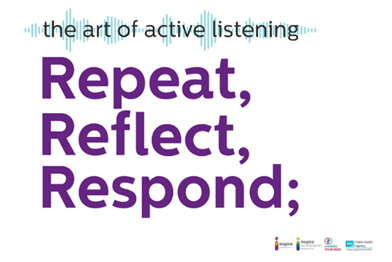the art of active listening
The Art of Active Listening is a campaign highlighting the importance of listening and encouraging people to develop their active listening skills.
What is Active Listening?
Opening up and talking about our concerns and feelings will often have a therapeutic effect. Many of us prefer not to talk about what’s bothering us; however, reaching out, either to share our own problems or act as a sounding board for others in need of help, is a valuable, simple way of easing worries.
The ability to listen, to take in and digest what we’re hearing, is a crucial tool when it comes to offering support. Listening effectively is something many of us can develop in order to benefit ourselves and those with whom we interact.
Given that we take in the spoken word at a much slower rate than we think, it is only natural that we struggle to concentrate fully on what other people are saying. That said, once we’ve taken the key first step of starting a conversation with some open-ended questions, the next part is easy. For additional information and resources on Asking, Talking and Listening, visit Change Your Mind.

The art of active listening is based on the three Rs: Repeat, Reflect, Respond:
Repeat: Repeating the things we’ve been told demonstrates, at the very least, that we’re attuned to what we’re hearing. It helps to show that we’ve understood and we can better do this by summarising the other person’s statements or repeating a word or phrase, prompting them to go on, safe in the knowledge that we are engaged listeners.
Reflect: We can maintain the conversation by reflecting on what we’ve heard, offering some basic insights into the other person’s experiences. A question like “So, you’re feeling hurt by the situation but you still enjoy working there?” allows us to delve deeper and provide more support. If people gloss over important details, we can try asking “Why not tell me more about that?” Either approach helps us clarify things for everyone involved.
Respond: Don’t feel obliged to remain impassive. Responding to what we’re being told displays our interest; it signals to people that their issues are worthwhile. “That must have been terrible” or “I’m sorry to hear you’ve had an awful time” are straightforward, supportive statements, although, sometimes, silence can also be fine. Concentrate on non-verbal responses. Nodding our heads, maintaining direct eye contact and staying quiet while the other person talks; all are cues that indicate our attention
What you say shouldn’t influence what the other person has to say. It just encourages them to talk. Let the person express their feelings and listen carefully to what they have to say. Listen without judgement and let them know you are there to help. For more information and advice visit Minding Your Head.
How to get involved in the campaign?
The campaign is running from the 10th September to 10th October. We are encouraging YOU and your team to get involved. Have a coffee morning, host a mindfulness session or even go for a walk with your colleagues at lunch… Last year, many organisations supported our campaign, making World Mental Health Day one of our most popular and wide-reaching campaigns.
This year, we would like to spread the importance of the art of active listening within your organisation, with the people you support and with the communities in which you work. It’s a unique and important message and we have developed a number of resources you can use. Email the team here to find out more.
This campaign is supported by the Public Health Agency. For more information on the PHA visit their website.